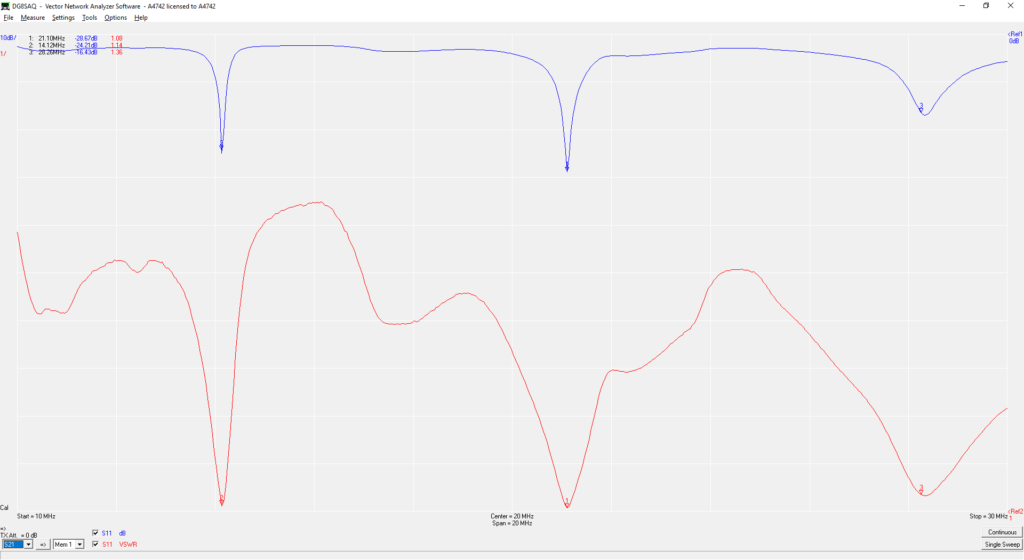I’ve spent the last week with Rob M0VFC and Dan M0WUT on a DXpedition to Montserrat as VP2MUW. This post is part-diary, part-informative for anyone who wishes to follow in our footsteps.
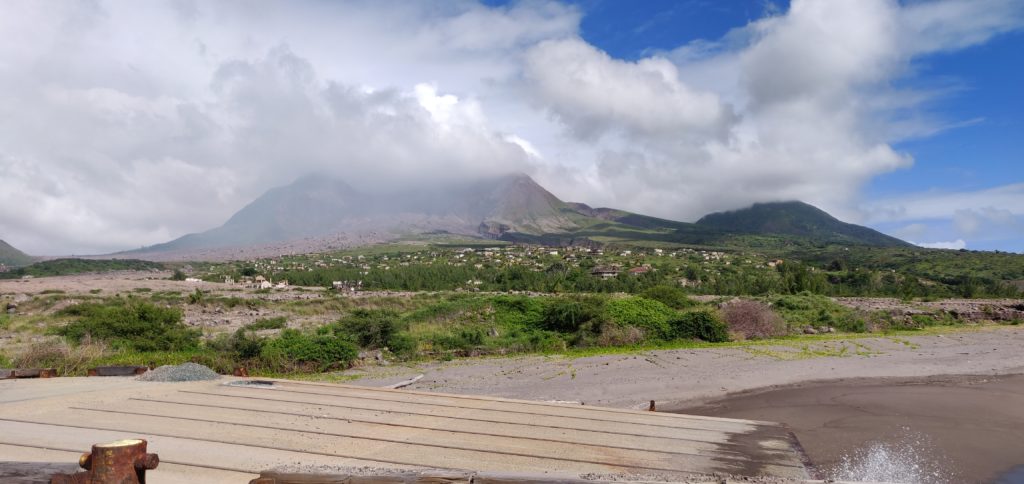
Plymouth, Montserrat
Travelling to Montserrat
Montserrat’s main airport was destroyed by the volcano eruptions in 1997 and 2010. Today, there is just a small airstrip on the island, but it can only support small planes, so luggage allowances are limited. Instead, we flew to the neighbouring island of Antigua, took a taxi across the island, and then onto the Jaden Sun ferry (actually a catamaran) from Antigua to Montserrat. This allowed us to take all our equipment without any hassle.
Our British Airways flight from Gatwick arrived at about 3pm. It then took about 30 minutes to get through Antiguan immigration and customs before we could get into the taxi. The airport has a very efficient taxi rank, which includes giving a guaranteed price for the taxi. For the three of us with our luggage, it cost US$14 for the 25 minute journey across the island to St John’s harbour. (Note that in both Antigua and Montserrat, prices may be quoted in either East Caribbean Dollars (XCD) or US Dollars (USD). Both currencies are widely accepted, however things tend to be more expensive in USD.)
The ferry port was a fairly disorganised place. There are two separate booths, one to collect the ferry ticket and register for the crossing, and the other to go through emigration formalities. There is also a further customs booth for paying Antiguan departure tax if you are eligible to pay it (see below). You have to check in 90 minutes before the sailing but, even having done all these bits of paperwork nice and early, we still had to wait as disembarking passengers coming from Montserrat had to go through similar formalities before we were allowed to board… and Customs hadn’t turned up to process them!
The ferry crossing takes about 1.5 hours and we arrived in Montserrat at 9:30pm – half an hour late because of the Customs delay in Antigua and it then took another 30 minutes or so for us to clear immigration into Montserrat. Luckily, David from Gingerbread Hill was there to pick us up and was prepared for the wait.
A quick word about how immigration and departure tax works: in Antigua, we indicated on our landing cards that we were in transit, and we got special visas accordingly, marked MNI on the way out and LGW on the way back (airport codes for Montserrat and Gatwick respectively). You are exempt from Antiguan departure tax if you have been in Antigua for less than 24 hours and so having these special visas saved us that cost. On the return journey we did need to show our BA boarding passes in order to get the LGW visa (we had already checked in for the flight online); on the outbound journey I had printouts of the ferry reservation available but these weren’t required.
The return journey was the same but in reverse, although timings were slightly more critical. We took the risk of getting the evening ferry from Montserrat at 5pm, arriving into Antigua at 6:30pm. This didn’t leave a huge amount of time for clearing customs and making it across the island in time to check in for our flight at 7:50pm. (Especially as Friday evening is the time that Antiguans like to go en masse to the KFC drive-through, I kid you not! This led to an extra traffic jam around the restaurant, adding about 5 minutes to the taxi journey.) It all worked out fine, however, and we were glad to take the risk as the alternative would have been to get the 6am ferry and wait around in Antigua with our luggage all day. Incidentally, departure tax is also payable when leaving Montserrat. This was EC$45 each plus a EC$10 security charge. The only thing to note is that the PeliCases containing the two amplifiers were sent to outsize baggage at Antigua airport where they were manually checked thoroughly, and we did need to show our radio licences.
We flew in British Airways ‘World Traveller Plus’ (their marketing name for Premium Economy). While not the most economical use of the Avios points (the International Airlines Group marketing name for air miles) we were burning, it gave extra baggage allowance, and the extra comfort and legroom were particularly welcome on the overnight flight back to the UK.
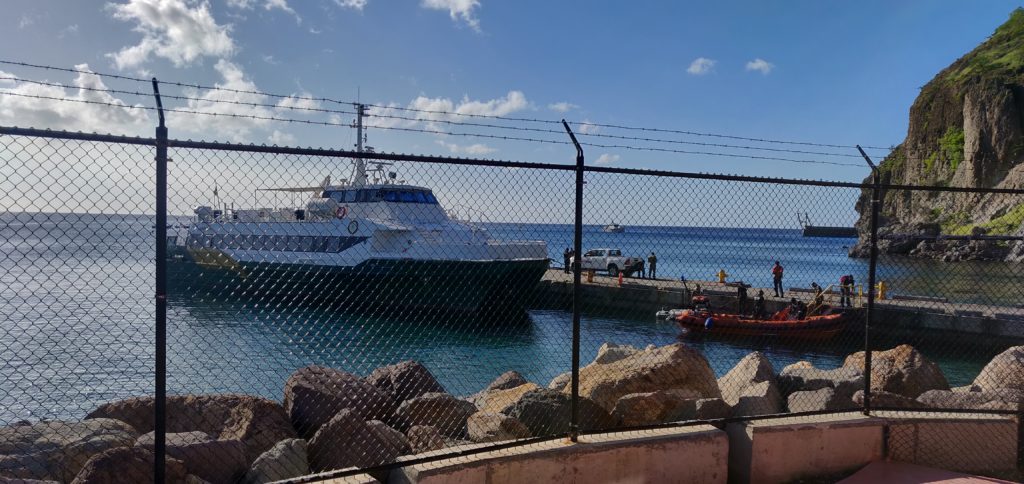
Jaden Sun
Radio from Gingerbread Hill
We stayed at Gingerbread Hill, well known among radio amateurs for the fact that the villas contain a ham station, tribander yagi and mast. It also has a fantastic sea-path take-off to the US and a reasonable take-off to Europe. We rented both the Heavenly Suite and Two Bedroom Villa (the suite being the upper floor of the same building as the villa). Both the suite and villa have double bedrooms, and the villa also has a room with two single beds. Amateurs take the Heavenly Suite as that provides roof access to the mast, but it’s strongly recommended you also book the villa – as we did – to prevent disruption to any non-ham guests in the same building.
From the equipment at Gingerbread Hill, we used the tribander and mast, some coax, 80m and 40m dipoles, and the rotator. Everything else we brought ourselves, including 3xK3s, KPA500, Juma amp, CW keys, power supplies and other wire antennas. Massive thanks, of course, to K2DG who keeps his equipment at Gingerbread Hill and makes it available to other visitors. There’s some slightly outdated information on his website, but I’d recommend anyone else emails him directly before travelling to get the latest information about the condition of the gear.
On the topic of power supplies, Montserrat uses two electrical standards and Gingerbread Hill is no exception. There are both 110V American style plug sockets, and 240V (we measured 238V) British three-pin sockets. This obviously makes using amps easier than in most other parts of North America. On the other hand, Montserrat does suffer from regular powercuts, as the entire island is apparently serviced by just one 1.5MW diesel turbine, although some experimentation with geothermal energy in association with an Icelandic company is also in progress. We had three or four powercuts over a couple of days, each lasting around 30-90 minutes. We did have a 5000mAh LiPo battery with us, so we could continue making some contacts on one station during one such event. By the way, a very modest extra charge for electricity is added to the Gingerbread Hill bill for ham operations. We were charged EC$27 per day.
Licences need to be applied for, ideally about 3 months in advance of the trip. The instructions and application form are on the MCIA website. The MCIA office is very close to Gingerbread Hill and Clover (David’s wife) kindly offered to collect the licences for us and to add the licence fee to the credit card she was already holding for the room booking, making the licensing process very easy.
On our arrival, David from Gingerbread Hill kindly showed us where the beam (Mosley C-33-M) is kept in the store, provided tools to build it and also gave us a couple folding tables to use in the shack. We found the beam easy to assemble, although a dodgy bolt badly affected SWR at first. After replacing the bolt and liberally applying tape to the joint, the VNA plot looked like a great antenna:
The beam is very easy to mount on the tower, because when down, the tower is at the height of the Heavenly Suite roof. It’s worth nothing that the beam is very much either on CW or SSB. With the beam tuned for the CW ends of the bands, SWR on 20m SSB was above 2:1, causing the KPA500 to complain. We therefore used a separate 20m vertical for 20m SSB, which also gave us the ability to be on 15m and 20m simultaneously. The tower itself has an electric motor, powered from outside the Two Bedroom Villa. We found it useful to use a couple UHF handhelds to talk from the rooftop to the person controlling the motor.

Antennas at Gingerbread Hill
1) Mosley C-33-M tribander; 2) 20m vertical; 3) 17m vertical; 4) 80m dipole; 5) 40m dipole; 6) 30m dipole
At this poor stage of the sunspot cycle, we made about 7500 contacts in the 5 days of operating between the 3 stations, mainly in CW with some SSB on 20m and 17m. We expected some backlash against publicising that we would not operate on FT8, but we actually only received positive comments about that decision.
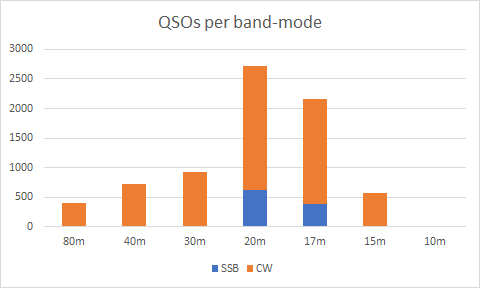
VP2MUW QSOs per band / mode
Despite the adverse conditions, we had several hours with over 150 contacts/hour, even reaching about 270 contacts/hour at the peak:

QSO rate at VP2MUW
With the three stations, we seemed to be able to make the most of the bands that were open at any given time we were active. In the graph below, a dot appears for the band if we made at least one QSO on the band in the hour:
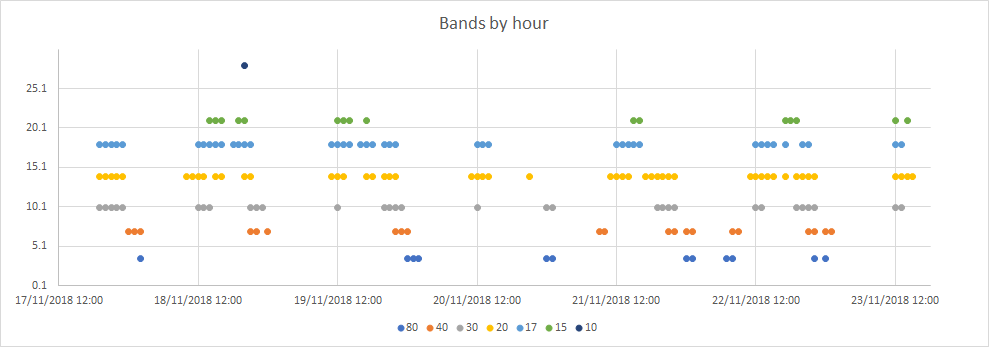
Bands we used over time
In terms of openings, we were very conscious of a good greyline path to Japan on 18MHz, 14MHz and 10MHz at our sunset, Japan’s sunrise. This was a great contributor to getting 223 JA stations in the log. We also ensured we were up at our sunrise to get the European opening on 40m in addition to the late-evening our time opening to EU on 80m. One morning, I also woke at 3:30am for the Europeans on 80m.
Into the Exclusion Zone
One of the things Clover arranged for our visit was a day-trip with Montserrat Island Tours around the island and into the Exclusion Zone. (Our tour guide was her son, Sunny.) This was well worth it. The morning tour included going to Jack Boy Hill to look out over the site of the former airport, now a flat plain of ash. We also visited a steam-powered sugar mill. (This is believed to have been an experimental feature, as most sugar mills operated fine with wind power.) After lunch at The Attic in Salem, we met with our police escort to enter the Exclusion Zone, the part of the island which is restricted due to continuing danger from the volcano. It should be noted that entry to the Exclusion Zone is not to be taken for granted. Just because you have arranged it doesn’t mean it will happen. It is only possible if the current Alert level is 0 or 1 (out of 5), and there have not been any heavy rains which could have flooded the roads in ‘mudslides’ of ash. The current Alert Level is posted on the Montserrat Volcano Observatory website.
The volcanic eruption which caused the evacuation and eventual abandonment of the capital, Plymouth, happened over 20 years ago in 1997, but the island is still far from recovering from it. Besides the lack of airport and insufficient electricity supply, hospitals and schools are also somewhat limited according to our guide. Heading into Zone ‘V’ (the most restricted area), the scale of the devastation was clear.
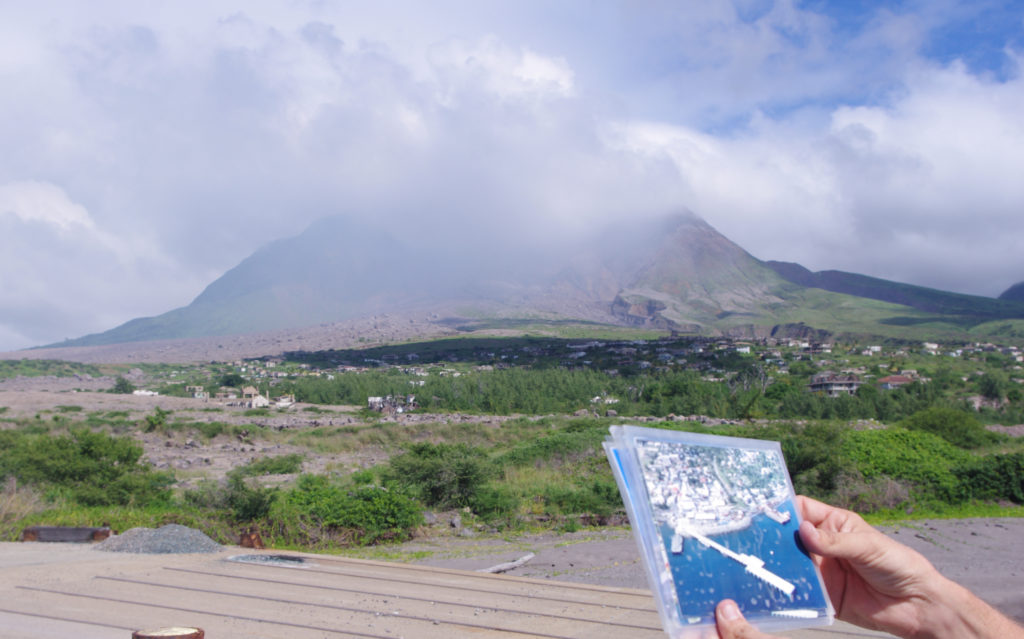
Plymouth: Before and After
Even with our police escort, continual radio contact with the Montserrat Volcano Observatory, and experienced local guide, we were still limited in where we could go within Plymouth. With so many buried buildings, many parts of the former town haven’t yet been mapped for any voids that might be under the ash, which you could fall into. Furthermore, there was a requirement to keep the car engine running while we were there and to not venture too far from the car, in case a speedy exit to the escape route were to be required.
It was amazing just how much deterioration has happened in the last 20 years. Compared to photos of Pripyat (the abandoned town near Chernobyl), which has been empty since 1986, the buildings in Plymouth have obviously been affected by the salt water and hurricanes in the much shorter timeframe. It’s especially heartbreaking to realise that when the volcano struck the town had only just finished rebuilding itself following the devastation of Hurricane Hugo in 1989.
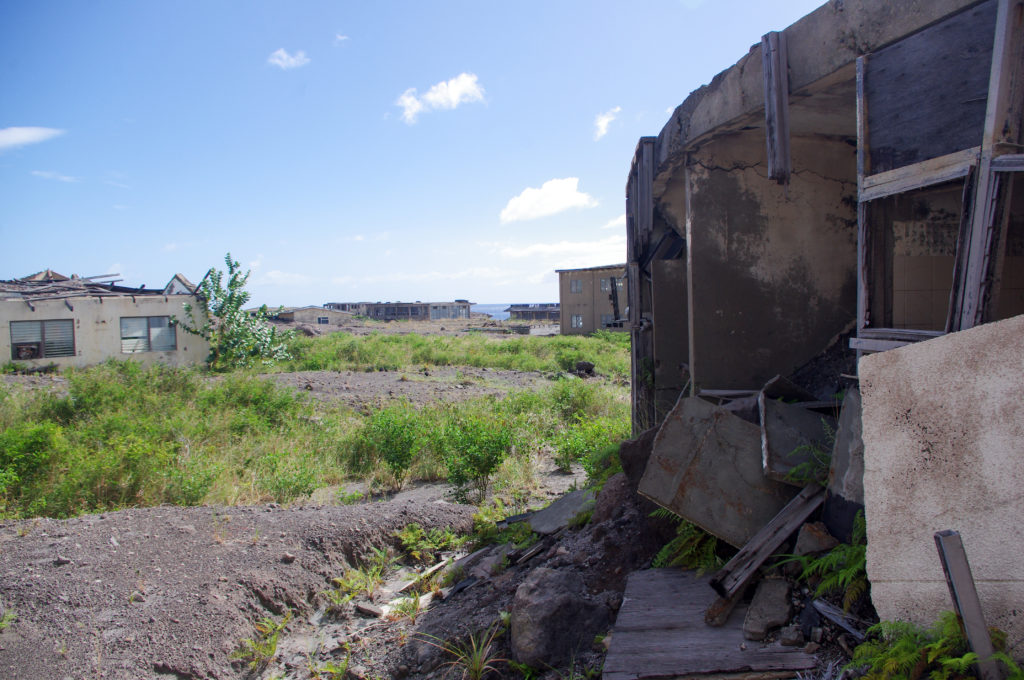
Abandoned buildings in Plymouth
While in Plymouth, our guide told us a couple anecdotal stories from the evacuation period. The first was the raid on the Barclays Bank vaults, with EC$1 million in brand new notes stolen from the branch. All that remains of the branch – and indeed the bank’s presence on the island today – is a light-blue painted fascia board rising above the ash and rubble. (Read an Associated Press report on the heist)
We were also told the story of one inhabitant of Plymouth with learning problems, who refused the order to evacuate and lived for several weeks with the whole town to himself before he was eventually caught up in a pyroclastic flow. It is believed that he was responsible for the pile of glass baby-food jars piled up in the corner of what was once the supermarket warehouse – he was eating his way through the stock while nobody was around.
After an hour or so in Plymouth, we went to the nearby settlement of Richmond Hill, also abandoned, where the former four-star Montserrat Springs Hotel stands. We had more freedom to wander around the hotel and to see the volume of ash which has invaded the bedrooms, as well as the destruction to the exterior of the building,
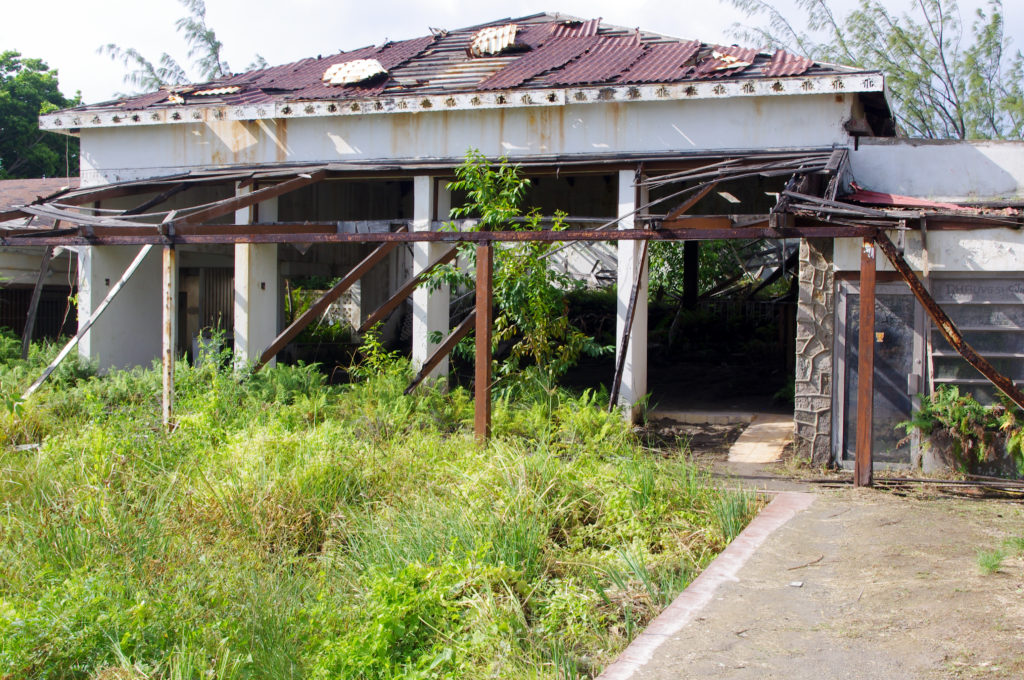
Outside bar and swimming pool at the abandoned Montserrat Springs Hotel
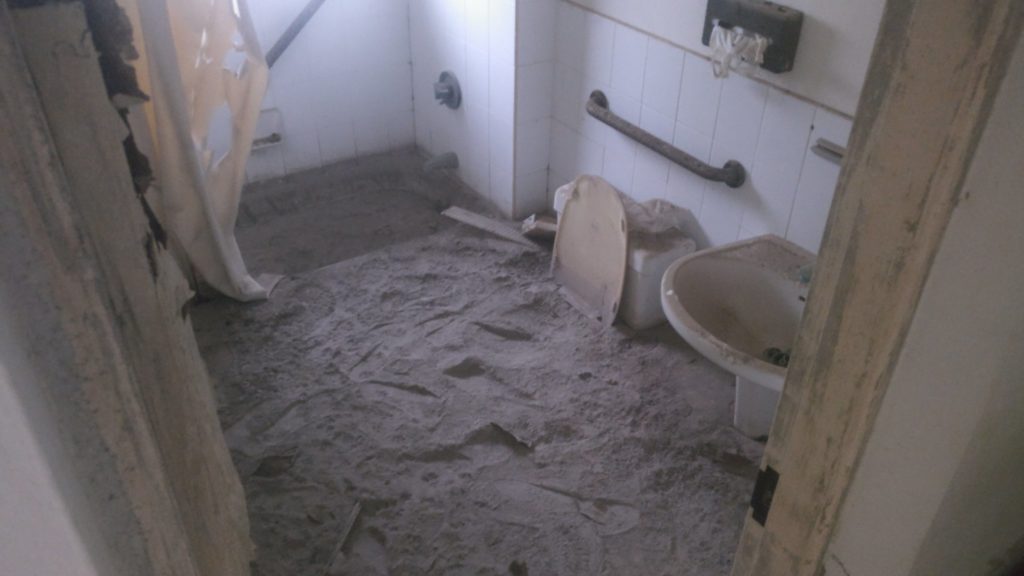
Volume of ash in the bedrooms at Montserrat Springs Hotel
Other tips for Montserrat
This is an assortment of other stuff I might have wanted to know before we went:
As you’ll have gathered, David and Clover, the owners of Gingerbread Hill, were excellent in recommending arrangements for our stay. One added bonus was that they arranged a hire car for us and, after we arrived on the boat, David took us to the police station in Brades to get our driving licences – and yes, the police station was open for business at 10pm! (There’s no automatic reciprocity for driving licences in Montserrat, but a trip to the police station, showing your home driving licence and paying EC$50 gets you a Montserrat driving licence.) This was absolutely invaluable. The shops in Brades are about 8 minutes’ drive from Gingerbread Hill down twisty, hill roads. As a result, everyone drives everywhere. The video below shows a sped-up version of this journey.
Similarly, the supermarket in Brades stays open late into the evening, and David also took us there to get immediate essentials once we had got off the boat on our arrival. It’s not fantastically well-stocked (by British standards it’s more like a corner shop than a supermarket) but it has enough to get by on. The owners also make their own curries, which are kept in the freezers in the shop in unlabelled containers. They are very nice indeed!
Water at Gingerbread Hill is potable, and very nice (it’s been filtered through volcanic rock, of course!). David provides water bottles in the fridge that you can keep cool.
David and Clover have recently completed building a small open-air swimming pool at Gingerbread Hill, which is a perfect way to cool off after lunch, when the bands have closed as they tend to do at midday near the equator. It has a lovely view out over the Caribbean.
The oven and hob in the accommodation are gas-powered (fed from gas bottles), meaning you can cook during powercuts. We didn’t use the microwave oven, but there is one in both kitchens. There’s also some emergency lighting (torches) in the Heavenly Suite but I found it useful to supplement this with the headtorch I had bought with me.
Gingerbread Hill has decent fast WiFi for internet access, however outside the villa you don’t want to even consider using data on a British mobile phone. Rates are in the region of £4-£6 per MB. Instead, Rob got a Transatel DataSIM for data in Antigua and Montserrat.
As well as Gingerbread Hill, David also helps run the Hilltop Café, a community café not far from Gingerbread Hill. Opening hours are limited but the Saturday morning Belgian Waffles with tropical fruit toppings are not to be missed. The Hilltop is also fascinating for containing many relics rescued from Plymouth during the evacuation period, including road signs from outside Government House, shop signs and even a TV camera from the local TV station, which closed down after the loss of their studios.
Montserrat is a windy place! Wind was a regular feature throughout our stay but it was unexpected. There were also some heavy rain showers at the start of the week, which kept the air quite humid, but they were short-lived and not too much of an inconvenience. You soon dried off in the heat naturally.
Costs
One of the most common questions on these trips is, how much did the trip cost?
The flight was, of course, the most expensive part of the trip but was paid for using Avios points and a British Airways 2-for-1 voucher. By way of a tip, if you are a UK-based DXpeditioner – or any other regular long-haul traveller – and you don’t currently hold a British Airways Premium Plus AmEx credit card, you’re missing out. (Standard disclaimer: I am not a financial adviser. These cards may not be suitable for everyone. They have a high annual fee, currently £195, and a representative APR of 76.0%. If you want to apply for one of these cards, I can provide a mutually-beneficial referral code.)
The rest of the trip came in at about £1000 each. This includes about £595 for Gingerbread Hill, £90 each for the return ferry, £80 for our rental car, £75 for the tour, £55 for groceries (we ate fairly frugally), £20 for the radio licences, £15 for parking at Gatwick, and £15 for eating out. We took £400 as East Caribbean Dollar cash between us, which was almost exactly what we needed after the villa, ferry, rental car, tour and radio licences had been paid by card.
We’ve had some generous donations with requests for QSL cards, which help offset the cost of printing the cards. Thank you to those donors.
